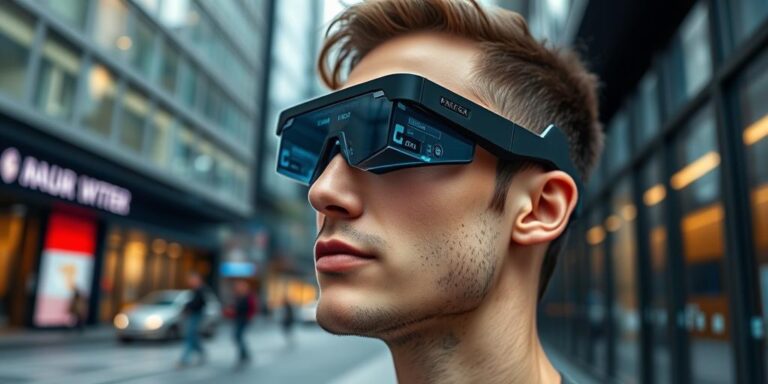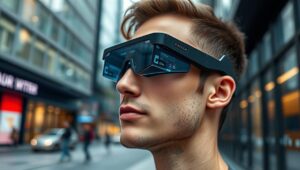Mainstream AR Glasses: What Will It Take by 2026?
Augmented Reality (AR) glasses have long been touted as the next big thing in personal technology. Yet, despite significant advancements, they haven’t achieved mainstream adoption. What are the key hurdles, and what needs to happen for AR glasses to become a common sight by 2026?
Current State of AR Glasses
Today’s AR glasses, such as the Microsoft HoloLens 2 and Magic Leap 2, are powerful but primarily cater to enterprise applications. These devices are used in industries like manufacturing, healthcare, and design for tasks such as remote assistance, training, and visualization.
However, the consumer market remains largely untapped. Devices like the Nreal Air offer a glimpse of what’s possible for everyday use, but they still face limitations in functionality, design, and ecosystem support.
Key Challenges to Mainstream Adoption
Several factors are currently hindering the widespread adoption of AR glasses:
- Form Factor and Comfort: Current AR glasses are often bulky and uncomfortable to wear for extended periods. Mainstream consumers prioritize comfort and aesthetics, so sleeker, lighter designs are essential.
- Battery Life: AR glasses consume significant power due to their displays, processors, and sensors. Limited battery life makes them impractical for all-day use.
- Display Technology: Achieving high-resolution, wide field-of-view displays in a compact form factor is a major challenge. Current displays often suffer from limited brightness, contrast, and color accuracy.
- Processing Power: AR applications require powerful processors to handle real-time object recognition, tracking, and rendering. Balancing performance with power efficiency is crucial.
- Software and Ecosystem: A robust ecosystem of AR applications and content is needed to drive consumer demand. Developers need tools and platforms that make it easy to create compelling AR experiences.
- Connectivity: AR glasses need seamless connectivity to smartphones, Wi-Fi networks, and potentially 5G for data processing and content streaming.
- Price: High price points put AR glasses out of reach for most consumers. Lowering the cost through economies of scale and technological advancements is necessary.
What Needs to Happen by 2026?
For AR glasses to become mainstream by 2026, significant progress is needed in the following areas:
-
Technological Breakthroughs:
- Miniaturization: Advances in micro-optics, display technology (e.g., micro-LEDs, holographic displays), and chip design are needed to create smaller, lighter AR glasses.
- Power Efficiency: New battery technologies and low-power processors are essential to extend battery life.
- Improved Sensors: More accurate and efficient sensors for tracking, object recognition, and environmental understanding are crucial.
-
Software and Ecosystem Development:
- AR Platforms: Development of robust AR platforms and SDKs that make it easier for developers to create AR applications.
- Killer Apps: The emergence of compelling AR applications that solve real-world problems or provide unique entertainment experiences.
- Content Creation Tools: User-friendly tools for creating AR content that anyone can use.
-
Design and User Experience:
- Sleek Designs: AR glasses that look like regular glasses or sunglasses and are comfortable to wear.
- Intuitive Interfaces: User interfaces that are easy to learn and use, with voice control, gesture recognition, and other natural input methods.
- Social Acceptance: Overcoming social stigmas associated with wearing AR glasses in public.
-
Strategic Partnerships and Investments:
- Industry Collaboration: Collaboration between technology companies, content creators, and fashion brands to develop and promote AR glasses.
- Venture Capital: Continued investment in AR technology and startups.
Potential Use Cases in 2026
If these challenges are addressed, AR glasses could become commonplace in various aspects of daily life by 2026:
- Navigation: AR-powered navigation systems that overlay directions on the real world.
- Entertainment: Immersive gaming, movies, and live events with AR overlays.
- Communication: Enhanced video calls with AR avatars and shared virtual spaces.
- Shopping: Virtual try-ons for clothes and accessories, and AR-powered product information.
- Education: Interactive learning experiences with AR models and simulations.
Conclusion
Mainstream AR glasses by 2026 are within reach, but it requires overcoming significant technological, software, and design challenges. With continued innovation, strategic partnerships, and a focus on user experience, AR glasses have the potential to revolutionize how we interact with information and the world around us. The journey to mainstream adoption will be an exciting one to watch.




